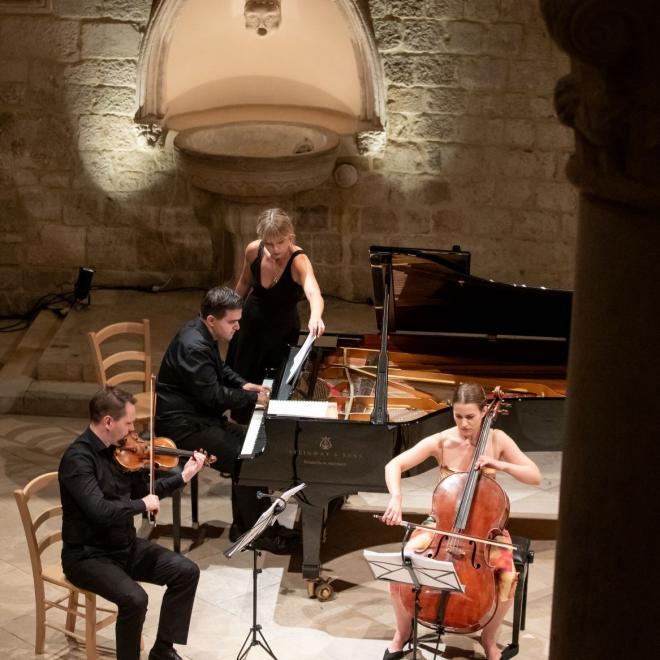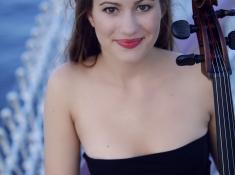
- More
- Performances
- Galleries
- Artists
Latica Anić, cello
Krešimir Starčević, piano
Marco Graziani, violin
Concert on the occasion of the 150th anniversary of Sergei Rachmaninoff's (1873-1943) and Blagoje Bersa's (1873-1934) birth
PROGRAMME:
Blagoje Bersa:
Piano Trio in Classical Style, Op. 7
I - Presto
II – Poco sostenuto, cantabile
III – Scherzo (Allegro)
Sergei Rachmaninoff:
Trio élégiaque No. 1 in G minor
***
Sergei Rachmaninoff:
Trio élégiaque No. 2 in D minor, Op. 9
I - Moderato
II – Quasi variazione
III – Allegro risoluto
--
MORE ABOUT THE PROGRAMME:
Notes by Dina Puhovski
The musicians performing this evening wrote the following about their project:
‘To mark the 150th anniversary of their births, violinist Marco Graziani, cellist Latica Anić and pianist Krešimir Starčević decided to prepare a special concert programme in 2023, composed of their piano trios. Although Rachmaninoff's Trio élégiaque No. 1 is often performed on Croatian concert stages, his Trio élégiaque No. 2, just like Bersa’s Piano Trio Op. 7, has not been performed in Croatia in the last three or more decades. Rachmaninoff’s piece is one of the most difficult piano trios ever written, with a performance time of 45 minutes, very challenging in terms of interpretation, which is why not many pianists dare to perform it. On the other hand, the probable reason why Bersa’s piece is so rarely performed is the lack of recently published sheet music, which was fortunately resolved with the Croatian Music Institute’s publication from 2011.’
We might add that Rachmaninoff’s Trio élégiaque No. 2 was in fact performed at the Julian Rachlin & Friends Festival here in Dubrovnik in 2008, but this is just the exception that proves the ‘rule’ of non-performance. In their concert announcement, the musicians quote Marija Bergamo’s text from the Editor’s Note of the sheet music edition of Bersa’s Trio, Op 7:
‘Blagoje Bersa’s chamber music output was not large. It consists of four works. As a composer of large opera and orchestral forms and a master of vocal and piano miniatures, Bersa wrote chamber music only during his music studies. (…) He wrote Trio for piano, violin and cello, Op. 7 (1895–1897), between his studies at the Croatian Music Institute’s Music School in Zagreb and at the Vienna Conservatory under Robert Fuchs. (…) The creation and later fate of the Trio is marked by doubts and misunderstandings, which is not surprising considering the condition of the autograph, with all its subsequent alterations. Kept in the National and University Library in Zagreb, it contains two fast movements of unequal size. The first is an extensive Presto movement (in B-flat major), followed by a short Scherzo (in E-flat major). Bersa crossed out the title Scherzo with a red pencil and changed it to Finale, adding the Roman numeral III. He dated the movement 16 January 1897, which means he wrote it later, when he was already studying in Vienna. Three bars of a Larghetto (in A-flat major) were added (and then crossed out) on the last page of the autograph.
The piano trio is therefore a piece whose title originally, when it was written in Zagreb in 1895, probably referred to the ensemble, not the form. Bersa apparently also composed the Scherzo, as an independent movement, in Vienna at the end of 1896 and beginning of 1897, perhaps as a part of a study assignment. Then he decided that, by adding a slow movement (the unfinished Larghetto), he could connect the two movements into a classical trio (although the Scherzo form is very unusual in this style, which supports the assumption that it was initially an independent work).
In 1934, immediately after Bersa’s death, Bersa’s student Zvonimir Bradić attempted to finish his teacher’s piece and preserve it for the future. With or without Bersa’s sketches (which is difficult to determine today), he composed the missing movement (Poco sostenuto – Cantabile in E major, in 3/4 time), signed it with his name and dated it October 1934. He tried to stay within the conceptual framework of the existing two movements with the type of melody, the texture of the accompaniment and structure. He added more polyphonic dialogue between the two string instruments to the romantic-salon sound typical of the period. He also added the title under which the piece has been listed and published since then: Trio in Classical Style.’
In their text about this evening’s programme, the musicians wrote that Rachmaninoff had an ‘insecure and emotionally intense childhood’; he was a student at the St. Petersburg Conservatory until he failed all subjects, after which he transferred to the Moscow Conservatory, where he studied with ‘a notoriously strict piano teacher, Nikolai Zverev.’ The text continues:
‘That turned out to be a blessing for his career, as Rachmaninoff became one of the most skilled piano virtuosos. At his teacher’s apartment, the young musician met many leading artists of the time, including Tchaikovsky and Arensky, with whom he studied harmony. Tchaikovsky was the young pianist and composer’s greatest influence and inspiration. In January 1892, Rachmaninoff made his official debut in Moscow, playing solo works of Chopin, Liszt and Tchaikovsky, as well as some of his own chamber works: two miniatures for cello and piano and his Trio élégiaque No. 1 in G minor, which he had written in only four days. Like most of his music of this period, this single-movement piano trio was highly influenced by Tchaikovsky, although the composing idiom is already clearly Rachmaninoff’s own. There are a lot of similarities to the first movement of Tchaikovsky’s famous Piano Trio in A minor, written in 1882 after the death of Nikolai Rubinstein, the composer’s friend, teacher and the director of the Moscow Conservatory. The long first movement of Tchaikovsky’s Trio is a ‘Pezzo elegiaco’ (Elegiac Piece) and, like Rachmaninoff’s Trio élégiaque No. 1, it ends with a funeral march.’
This is followed by an analysis and interpretation of Rachmaninoff’s Trio élégiaque No. 2:
‘Almost two years later, Tchaikovsky died after a sudden illness (before conducting the first performance of Rachmaninoff's orchestral fantasy The Rock, which was his great wish). Rachmaninoff once again turned to this form and composed Trio élégiaque No. 2 in D minor, Op. 9, in memory of his mentor. It is a monumental three-movement piece, much larger than his first trio and, as one might expect, written with a lot of passion and true, deep emotion.
The opening of the massive Moderato reveals deep sorrow, emphasized by the repeated funeral accompaniment of the strings. The music, although very passionate, moves in a very deliberate, almost agonizing tempo. The second movement, Andante, quasi variazione, is also written on a large scale. The piano announces the theme followed by eight variations. During the long introductory solo at the beginning of the third movement, Allegro risoluto, the piano introduces a theme written in the style of Tchaikovsky, somewhat rough and interrupted with forceful outbursts of emotion. The pathos and passion are further heightened when the strings join in.
Trio élégiaque No. 2 is a dramatic and powerful piece that leaves a deep impression on listeners.’
--
- 07. August 2023./ Monday / 21:30 Rector's Palace Atrium +Tickets




